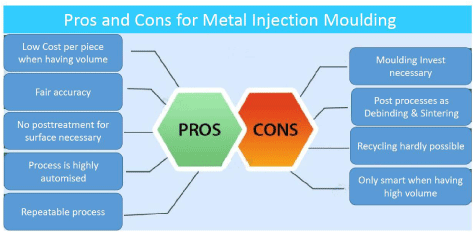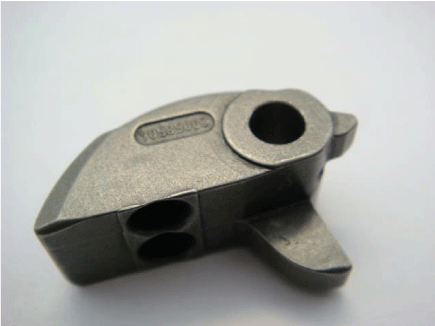International Journal of Nanomaterials, Nanotechnology and Nanomedicine
Nano material parts for medical analysis machine-applications
Thorsten Hickmann*
Cite this as
Hickmann T (2020) Nano material parts for medical analysis machine-applications. Int J Nanomater Nanotechnol Nanomed 6(1): 013-015. DOI: 10.17352/2455-3492.000034When it comes to application of specific material properties, high accuracy and minimal rework of nano-metal components are the key elements for a sucessful process. The parts can be either produced by Laser melting, or by metal injection moulding, depending on the volumes oft he desired applications.
These nanostructured materials are possible to produce on different material basis, however titanium is preferred. Both options are usable for medical parts. The technology is defined by the numbers of pieces which need to be produced.
Introduction
It is for good that the number of powder metallurgically produced parts continues to grow. The benefits are obvious, since the parts are produced in this way correspond very closely to the final geometry: They are characterised by very high accuracy as well as surface quality.
Development is processing to such a point that the quality of such parts may be higher than that of precision cast parts – but only if the manufacturing process is mastered.
Laser melting or Metalinjection Moulding
When looking at 2 technologies, it is necesassary to understand how the technology works and where the issues are. For Lasermelting, the technology is melting the steelpowder directly to the desired 3-d-geometry. For this technology, a lasermelting machine is necessary [1]. The geometry of the 3-d-printed part is cut into horizontal „slices“ and they are lasered layer by layer in the building area oft he machine [2,3].
For Metal Injection Moulding, the approach is completely different with the same final material, but a completely different process: Here the mix out of polymer and metal powder is injected into the injection moulding machine. Then the part is demoulded fully automatically [4].
And then, the material is injected part is post treated by debinding and sintering process. In this regard, the mould, the injection moulding machine, the laser melting machine and experience represent the key factors that preserve special attention in ordert o evaluate the question what technology to use (Table 1).
Figure 1: Comparison Laser Melting and Metal Injection Moulding
Figure 1 shows what technology can be used depending on the requirements of the desired parts. Apart from the volume, it is always also a question how big the parts are. Generally spoken Metal Injection Moulding is only applicable for high volumes und fairly small parts up to a part weight of 50 g (recommended) and maximum weight of 150g [4].
Laser melting as an option for small volumes
In this regard, the mould, the injection moulding machine, the laser melting machine and experience represent the key factors that preserve special attention.
Picture 1 shows a part which is produced via lasermelting. Here, the Core of an injection mould for a nasal douche part is prodced. The unique of this laser melted part is the inegrated cooling of the system. The different parts on the photo show the different production cycles oft he material. Here, it is necessary to consider the exact machine parameters[1], the correct design releaseases oft he material [2] as well as the adaquate machining strategy [3].
Production of parts via powder metallurgy has beeen practised for some time. For instance, powder metallurgy has been used for decaeds to produce friction bearings with properties that satisfy precisely the application requirements such as the essential one of operation inder emergency running conditions, among others. These benefits, however, can be realised economically only with moderate to large production quantitiers. For smaller volumes, laser melting is the best choice in order to produce medical devices [4].
For higher volumes, the combination of sintering with the relatively inexpensive process of injection moulding, which leads to injection moulding of metal powder represents one approche tp achieving this objectiove. Allmost all alloys that are available in powder form can be employed for this process. Standard steels, stainless alloys, as well as magnetic steel poweder can all be processed via injection moulding [5].
When looking at the pros and cons of this technology, the following pros and cons (Figure 2) can be considered.
Special know how for MIM for higher volume
Sucsessful implementation oft he MIM process requires special know-how, esprecially with regard tot he injection moulding machine and the mould. When injection moulding, it has been found that electronically controlled machines can be controlled more precisely via thei controls than can their hydraulice counterparts [4].
Attention must be also given tot he screw geometry in conjunction with the injection nozzle. No special measures are required for protection against wear, nitrided screws and barrels are satisfactory. For long production runs, hardfaced screws are recommended – as with the conventional injecion moulding.
Selection oft he injection mould is more difficult, since the part geometry and planned annual production volume must be taken into consideration along with the possibilities offered by the injection moulding machine.
When looking at this sample, it becomes evident that the selection of the gate location and a good cooling of the mould-system os the decisive criterion for success [5]. Based on the function of the part, the designer establishes where the gate , parting lines and ejector can be located. Her must have an idea of the mould filling behaviour for various approaches to gating and specify the most favorable one [6]. The detailed design concludes the work and should take all consideration into account.
When looking at the pros and cons of this technology, the following pros and cons (Figure 3) can be considered.
Outlook
Additional examples oft he succesful use of Nano-structured Lasermelted parts are other mold devices such as areas where the cooling oft he system is very important. As far as MIM-parts is concerned, other parts for Titanium applications can be used easily as MIM parts. The great advantage of MIM ist hat the materials can be processed via injection moulding and the material properties of both the plastic and metal can be tailored to the applications. The importance of metal injection moulding and also Laser melting of nanostructured pars will grow especially in the fields that require a combination of plastic injection moulding and the metalforming to meet demanding requirments. The author thanks the Federal Ministry of Education and Science for the donation in the project Kitkadd for Lasermelted applications [7].
- Adam (2015) Systematische Erarbeitung von Konstruktionsregeln für die additiven Fertigungsverfahren Lasersintern, Laserschmelzen und Fused Deposition Modeling. Forschungsberichte des Direct Manufacturing Research Centers. Link: https://bit.ly/3569np8
- (2019) VDI Richtlinien 3405 & VDI Statusreport „Realität in der industriellen Fertigung.
- (2020) VDMA, Gebhardt R () Detaillierte Roadmaps weisen Additive Manufacturing den Weg in die Smart Factory. Link: https://bit.ly/3aKIFmV
- Ebel T, Friederici V, Imgrund P, Hartwig T (2015) Metal injection molding of titanium“ in book: Titanium Powder Metallurgy, Darmstadt.
- Miranda RM (2013) Handbook of metal injection molding, Munich.
- Stevenson James F (2009) Powder Metal Injection Molding, Carl Hanser Verlag, Munich.
- (2019) Projekt KitKAdd. Kombination und Integration etablierten Technologien mit Additiven Fertigungsverfahren“, gefördert durch das Bundesministerium für Bildung und Forschung.

Article Alerts
Subscribe to our articles alerts and stay tuned.
 This work is licensed under a Creative Commons Attribution 4.0 International License.
This work is licensed under a Creative Commons Attribution 4.0 International License.



 Save to Mendeley
Save to Mendeley
